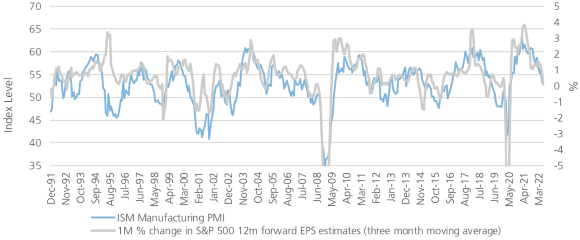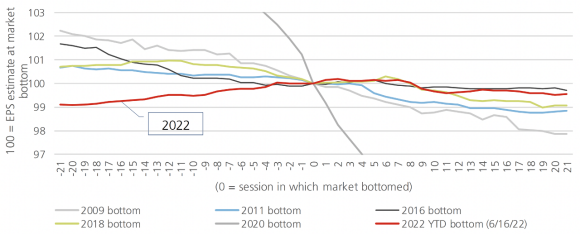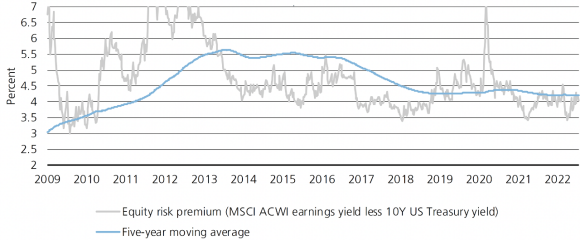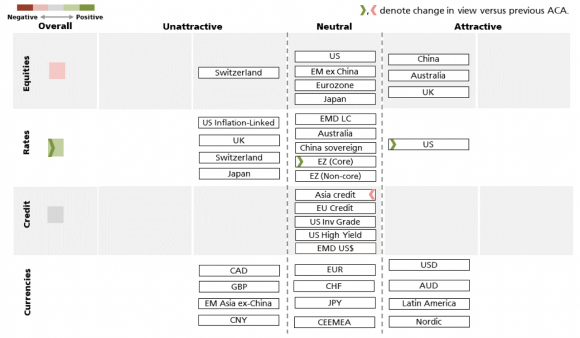Macro Monthly No painless pivot for risk assets
Economic insights and asset class attractiveness.
Highlights:
Highlights:
- In our view, the recent advance in global equities is a bear market rally, not the start of a new bull run.
- Earnings expectations do not reflect the retrenchment of goods-sector activity or reduction in household spending power.
- We believe the Federal Reserve will not shift from tightening to easing without substantial economic pain.
- Valuations are still on the expensive side, and recession risks are above-average.
- We are staying underweight stocks and using selloffs in bonds as an opportunity to increase exposure to sovereign fixed income.
Global stocks staged a major rebound in July, buoyed by resilient corporate profits and hopes that the point of maximum stress from central banks, elevated fuel prices, and higher mortgage rates has passed.
In our view, conditions getting less bad is enough to spark a relief rally, but not an enduring turn in the economic and risk cycle. We stay underweight global equities, expecting further negative revisions to earnings, a continuation of central bank tightening campaigns, and a lack of valuation support.
More pressure on profits
More pressure on profits
Earnings face downside risk even if the US economy avoids a recession. A downturn in the global goods sector is underway, and equities are much more levered to goods than overall economic activity, which is more services-oriented.
A retrenchment in manufacturing activity as part of a goods-to-services rotation was a high-probability event for 2022. But this rotation is being hampered by significant negative supply shocks that have weighed on real incomes and elicited aggressive monetary tightening to further slow demand. Slowing spending growth, an increase in inventories, wider spreads, and higher risk-free rates also point to weaker investment going forward.
Given this backdrop, analyst expectations for profit growth of 6.6% in 2023 for global equities on the heels of nearly double-digit growth this year are overly optimistic, in our view. Downward revisions in earnings are usually a prerequisite for stocks to be able to find a bottom. It would therefore be unusual for the June low to mark the trough of this bear market, as the process of cuts to aggregate earnings estimates had not yet begun.

Related
Macro updates
Macro updates
Keeping you up-to-date with markets
Exhibit 1: Manufacturing weakness implies more downside for profit expectations

Exhibit 2: How S&P 500 earnings estimates behave a month before/after recent major equity market bottoms

The rebound in equities over the past month, in our view, is not a signal of increased confidence in the economic outlook. Rather, the price action has the hallmarks of a short-covering rally and trend reversal, with market leaders turning to laggards (and vice versa). The best-performing factors within the US equity market have been growth, earnings variability, and volatility. The two worst-performing have been value and momentum. These violent reversals are a danger in bear market rallies, particularly when sentiment and positioning are depressed.
No painless pivot
No painless pivot
Throughout 2022, an increasingly hawkish Federal Reserve has been a potent negative catalyst for risk assets. So when Chair Powell suggested that the pace of tightening would slow at some point in the future, risk assets surged. We would caution extrapolating somewhat less Fed hawkishness to mean Fed dovishness.
Fed tightening is designed to slow inflation by bringing about below-trend growth and moderating the rises in aggregate income. This is a feature, not a bug, of policy, and it is on course to continue in light of continued strength in the labor market, especially wages. Our view is that the central bank is willing to tolerate – or even inflict – a substantial amount of economic pain to bring down price pressures before considering any easing. We believe that just as the Fed was behind the curve in removing stimulus amid hot inflation during a rapid expansion, so too will they be behind the curve in responding to economic deterioration.
Exhibit 3: Global equity risk premium implies stocks still expensive relative to bonds

Equity markets appear to have embraced the idea of the Fed cutting rates in 2023 while overlooking the economic damage required to get such an about-face, in our view. We believe there will be no such painless pivot. Consider that the central bank has hiked 150 basis points at its last two meetings, yet financial conditions have eased by an amount roughly consistent with 50 basis points’ worth of cuts1. Financial conditions that are more supportive of growth is something we expect the Fed will actively lean against, as it should not increase their confidence that underlying inflationary pressureswill moderate.
The Fed has officially abandoned formal forward guidance andthere is a stark divide between the central bank and markets as to the direction of policy rates over the next year. This difference of opinion is a recipe for rates volatility to stay at elevated levels rather than continue to recede, in our view.
No valuation support yet
No valuation support yet
Despite the earnings and Fed-induced challenges for risk assets, there would still be an argument to be overweight stocks if there was ample evidence that these risks are in the price. But in our view, this is not the case. Global stocks may have sold off year to date, but they are not on sale. The equity risk premium, the expected forward earnings yield for the MSCI All Country World Index less the yield on the US 10-year Treasury note, shows stocks are expensive relative to bonds. This exante extra carry from stocks relative to bonds has been at least 5% at all major market troughs since the 2008 financial crisis. Holding expected earnings and current yields constant, MSCI ACWI would need to be more than 10% lower to meet that valuation criterion.
The ability of lower bond yields to boost the relative attractiveness of stocks is also limited from here, in our view. We believe there would need to be much higher odds of recession – and in turn, even more downside risks to earnings – for bond yields to fall far below the Fed’s estimate of the neutral rate (around 2.5%).
Asset allocation implications
Asset allocation implications
In our view, the recent turn in the second derivative – inflation dynamics getting less bad – should not distract from the key feature of the outlook: activity is on a path to weaken from here. Risk assets have not yet priced in the extent of this economic deceleration. Some of the recent positives for stocks, like lower fuel prices, could prove to be a brief respite, and fresh facets of geopolitical risk between the US and China have the potential to roil markets.
Our positioning has a cautious tilt, as we remain underweight global equities and favor defensive regional, sector, and factor allocations. We are using selloffs in government bonds as opportunities to boost exposure in anticipation of a further economic slowdown. In addition, we are cognizant that equity markets can rally on narrow leadership, even when profit growth falters more broadly. Accordingly, we have boosted exposure to US technology stocks in select portfolios.
Asset class attractiveness (ACA)
Asset class attractiveness (ACA)
The chart below shows the views of our Asset Allocation team on overall asset class attractiveness as of 3 August 2022. The colored squares on the left provide our overall signal for global equities, rates, and credit. The rest of the ratings pertain to the relative attractiveness of certain regions within the asset classes of equities, rates, credit and currencies. Because the ACA does not include all asset classes, the net overall signal may be somewhat negative or positive.

Asset Class | Asset Class | Overall/ relative signal | Overall/ relative signal | UBS Asset Management’s viewpoint | UBS Asset Management’s viewpoint |
|---|---|---|---|---|---|
Asset Class | Global Equities | Overall/ relative signal | Light red | UBS Asset Management’s viewpoint |
|
Asset Class | US Equities | Overall/ relative signal | Grey | UBS Asset Management’s viewpoint |
|
Asset Class | Ex-US Developed market Equities | Overall/ relative signal | Grey | UBS Asset Management’s viewpoint |
|
Asset Class | Emerging Markets (EM) Equities (ex-China) | Overall/ relative signal | Grey | UBS Asset Management’s viewpoint |
|
Asset Class | China Equities | Overall/ relative signal | Light Green | UBS Asset Management’s viewpoint |
|
Asset Class | Global Duration | Overall/ relative signal | Light Green | UBS Asset Management’s viewpoint |
|
Asset Class | US Bonds | Overall/ relative signal | Light Green | UBS Asset Management’s viewpoint |
|
Asset Class | Ex-US Developed-market Bonds | Overall/ relative signal | Grey | UBS Asset Management’s viewpoint |
|
Asset Class | US Investment Grade (IG) Corporate Debt | Overall/ relative signal | Grey | UBS Asset Management’s viewpoint |
|
Asset Class | US High Yield Corporate Debt | Overall/ relative signal | Grey | UBS Asset Management’s viewpoint |
|
Asset Class | Emerging Markets Debt US dollar Local currency | Overall/ relative signal | Grey Grey | UBS Asset Management’s viewpoint |
|
Asset Class | China Sovereign | Overall/ relative signal | Grey | UBS Asset Management’s viewpoint |
|
Asset Class | Currency | Overall/ relative signal | - | UBS Asset Management’s viewpoint |
|
A comprehensive solutions provider
A comprehensive solutions provider
UBS Asset Management Investment Solutions manages USD 151.8bn as of June 30, 2022. Our 100+ Investment Solutions professionals leverage the depth and breadth of UBS's global investment resources across regions and asset classes to develop solutions that are designed to meet client investment challenges. Investment Solutions' mac ro -economic and asset allocation views are developed with input from portfolio managers globally and across asset classes. For more information, contact your UBS Asset Management representative or your financial advisor.
Read more
Make an inquiry
Fill in an inquiry form and leave your details – we’ll be back in touch.
Introducing our leadership team
Meet the members of the team responsible for UBS Asset Management’s strategic direction.


